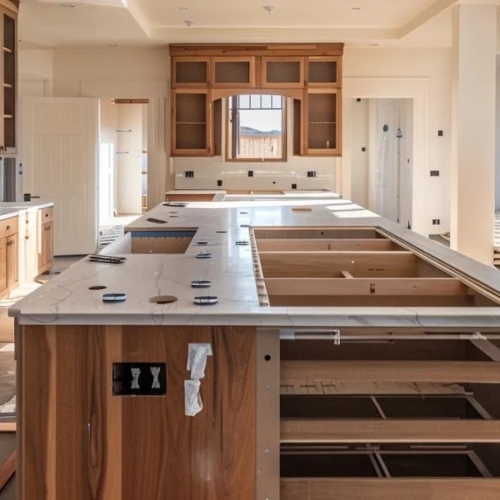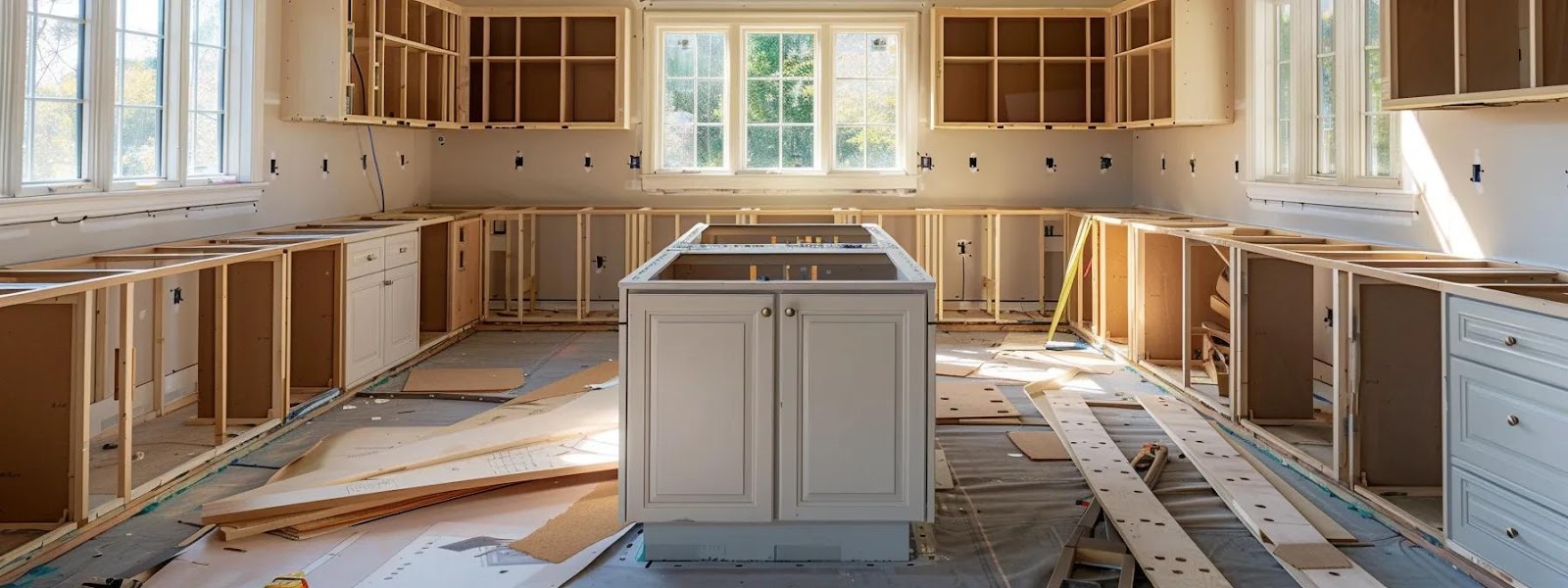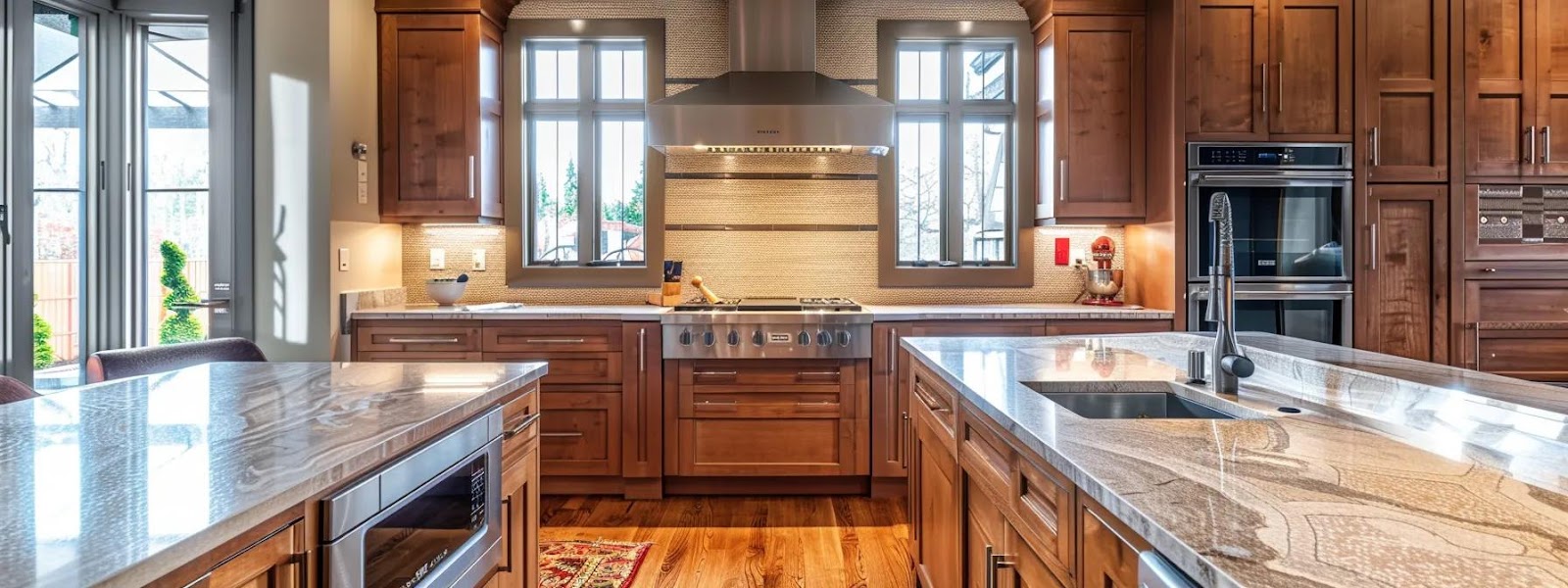Dishwasher Requirements for Commercial Kitchens
link desc

Building your own cabinets is usually cheaper than buying custom ones. You can save about 60-70% on costs by making them yourself. But buying stock cabinets is often the cheapest option overall, especially when you count your time and effort.
When planning your kitchen, you have three main choices that each offer different benefits and costs.
Stock cabinets are ready-made cabinets that come in standard sizes. You can buy them at home improvement stores like Home Depot or Lowe's. They're the fastest and cheapest option, but they come with limited style choices and standard dimensions that might not fit your space perfectly.
Custom cabinets are built by a professional cabinet maker just for your kitchen. They fit perfectly and look exactly how you want them. A skilled craftsman will work with you to create the perfect storage solution for your space, but they cost much more and take longer to make.
DIY cabinets mean you build the cabinets yourself using wood and tools. This takes the most time but can save you lots of money if you have the right skills. Many homeowners find this option rewarding because they get exactly what they want while learning new skills.
Understanding the true costs helps you make smart decisions about your kitchen renovation budget.
Stock cabinets typically cost between $100 to $400 per linear foot. For a standard 10x10 kitchen, you're looking at $5,600 to $12,000 for the cabinets alone. Installation adds another $100 to $200 per linear foot, so your total project cost ranges from $7,600 to $16,000.
Custom cabinets are significantly more expensive, ranging from $500 to $1,200 per linear foot. That same 10x10 kitchen could cost $15,000 to $30,000 or more. However, installation is usually included in the price, and you get exactly what you want with premium materials and craftsmanship.
DIY cabinets cost much less in materials, typically $60 to $200 per linear foot. A 10x10 kitchen might only cost $3,000 to $8,000 in materials. But you'll need to buy tools, which can add $1,000 to $3,000 to your one-time costs. The real expense is your time and effort.
One experienced DIY builder got a quote of $14,000 for big-box store cabinets but spent only $4,200 building them himself. That's a savings of almost $10,000! But he also spent months of weekends doing the work, learning new skills, and dealing with the stress of a major project.
This example shows the biggest truth about cabinet costs: building your own saves money, but costs lots of time and effort. You need to decide if that trade-off makes sense for your situation.
Building your own cabinets can be a smart choice if you have the right combination of skills, tools, and time.
You need experience with woodworking, knowledge of measuring and cutting wood accurately, and understanding of how to use power tools safely. Patience for detailed work is essential because cabinet making requires precision. Even small mistakes can be costly and time-consuming to fix.
The tool requirements are significant. You'll need a table saw or circular saw, drill and bits, pocket hole jig, clamps and sanders, and a router for fancy edges. Quality tools cost money upfront but can be used for other projects later.
Time is the biggest factor most people underestimate. A simple kitchen might take 2-4 weeks of weekends, while a complex kitchen could require 2-3 months of part-time work. If you're new to cabinet making, add 50% more time to account for the learning curve and inevitable mistakes.
Sometimes buying cabinets is the smarter choice, even if it costs more upfront.
Speed is a major advantage of buying cabinets. Stock cabinets can be installed in just a few days. Even custom kitchen cabinets take 6-12 weeks, which is still much faster than DIY.
If you're not handy with tools or lack woodworking skills, buying is definitely smarter. Mistakes in cabinet building can cost more than the savings from DIY. Professional cabinet makers have years of experience and know how to avoid common problems.
Your time has value too. If you make good money at your job, working extra hours might be better than spending weekends building cabinets. Calculate what your time is worth and factor that into your decision.

Understanding materials helps you compare options better and make informed decisions about quality and durability.
The choice between plywood and MDF affects both cost and performance. Plywood is stronger, handles moisture better, and costs more. It's made from thin layers of wood glued together, which makes it very stable and durable. MDF provides a smoother surface, costs less, but doesn't handle water well. It's made from wood fibers pressed together, creating a uniform surface that's great for painting.
Recent industry data shows that cabinets account for roughly 41% of a kitchen renovation budget, making material selection crucial for controlling costs. According to the U.S. Census Bureau's American Housing Survey, homeowners spent about $827 billion on home improvement projects in the two-year period ending in 2023.
Solid wood is the most expensive option but also the most durable. It offers natural beauty and can last for decades with proper care. However, it's prone to expansion and contraction with humidity changes, which can cause problems in some climates.
When considering what are the different types of cabinet finishes, remember that the finish affects both appearance and durability. Paint, stain, and clear coats each have different costs and maintenance requirements.
Many people underestimate the total cost of their cabinet project because they don't account for hidden expenses.
DIY hidden costs can add up quickly. Mistakes waste materials and can add 20-30% to your costs. Quality tools cost $1,000-$3,000, and your weekend time has value too. Don't forget finish materials like paint, stain, and hardware, which can add hundreds of dollars to your project.
Buying cabinets also has hidden costs. Delivery might cost $100-$500 depending on distance. Installation for custom cabinets runs $200-$300 per linear foot. Changes after ordering cost extra, and some areas require permits for major renovations.
The right materials depend on your budget, skills, and priorities.
For DIY builders, start with plywood for boxes and MDF for doors. This combination gives you strong structure that lasts, smooth doors that paint well, and a good balance of cost and quality. This approach is similar to what many professional cabinet makers use.
For cabinet buyers, look for plywood boxes rather than particle board, which doesn't hold up well over time. Solid wood doors or high-quality veneers provide beauty and durability. Features like soft-close hinges and full-extension drawer slides add convenience and value. Adjustable shelves give you flexibility for different storage needs.
When selecting materials, consider the environment where they'll be used. Best materials for laundry room cabinets differ from kitchen cabinets because of humidity and temperature differences.
This is often the deciding factor when choosing between building and buying cabinets.
Calculate your time value honestly. If you make $25 per hour at work, building cabinets that takes 120 hours represents $3,000 in lost potential income. Installing stock cabinets takes about 8 hours, representing only $200 in lost income.
Data from the U.S. Bureau of Labor Statistics shows that compensation costs for civilian workers increased 4.2% for the 12-month period ending March 2024, which affects both professional installation costs and the opportunity cost of your own time. Add this time value to your material costs to see the real comparison. Sometimes the "cheap" option isn't actually cheap when you factor in your time.
But remember that some people enjoy building things and find it relaxing. If you love woodworking, your time might be worth more than money. The satisfaction of creating something with your hands has value that's hard to measure.

Quality varies significantly between different approaches to getting cabinets.
DIY quality can be excellent or poor depending on your skills. You control every detail, which means you can create exactly what you want. But mistakes are common for beginners, and fixing them takes time and money. The result depends entirely on your commitment to learning and doing things right.
Stock cabinet quality is consistent and meets industry standards. These cabinets are mass-produced using proven methods and materials. However, options are limited, and they may not fit your space perfectly. You might need fillers or modifications to make them work.
Custom cabinet quality represents the highest standard because of professional craftsmanship and perfect fit. Skilled craftsmen use premium materials and time-tested techniques. But this quality comes at a premium price and requires longer wait times.
The best choice depends on your specific circumstances, not just the lowest price.
Choose DIY building if you have woodworking experience, own most needed tools, have 2-3 months of spare time, enjoy challenging projects, and have a very tight budget. This path offers the most savings but requires the most commitment.
Choose stock cabinets if you want the project done quickly, have a moderate budget, your kitchen has standard dimensions, and you don't mind limited style choices. This option balances cost, speed, and quality for most situations.
Choose custom cabinets if you have a large budget, want exactly what you envision, your kitchen has unusual dimensions, or you're planning to stay in your home long-term. This investment pays off in satisfaction and home value.
Smart shopping and planning can save money regardless of which option you choose.
DIY money savers include buying materials in bulk, using simple designs like shaker style which is easiest to build, skipping fancy hardware until later, and practicing on a single cabinet first. Learning from mistakes on a small project is much cheaper than ruining an entire kitchen's worth of materials.
Stock cabinet money savers include shopping sales and clearance events, buying unfinished cabinets and painting them yourself, installing them yourself if you're handy, and considering cabinet refacing instead of complete replacement. Sometimes a fresh look is all you need.
Custom cabinet money savers include choosing standard sizes when possible, picking simpler door styles, using plywood instead of solid wood for boxes, and getting quotes from multiple contractors. Even small changes in specifications can create significant savings.
Installation is often more complicated than people expect, whether you're doing it yourself or hiring professionals.
DIY installation challenges include ensuring cabinets are perfectly level, dealing with walls that are rarely straight, managing plumbing and electrical connections, and properly supporting heavy upper cabinets. These tasks require specific skills and tools that many DIYers don't have.
Professional installation offers experience with common problems, proper tools and techniques, warranty on installation work, and much faster completion. When considering how to maximize bathroom storage space with custom cabinets, professional installation ensures everything works properly from day one.
Think beyond initial costs to consider long-term value and satisfaction.
Resale value depends more on quality than whether you built or bought your cabinets. Well-built cabinets add significant value to your home. Buyers care about functionality, appearance, and durability, not who made them.
According to research from the Joint Center for Housing Studies at Harvard University, annual expenditures for improvements and maintenance to owner-occupied homes are expected to grow modestly through 2026, indicating continued strong demand for quality home improvements that add value.
Durability depends on materials and construction methods. Properly built cabinets last 20-30 years regardless of whether they're DIY or professionally made. The key is using quality materials and proper construction techniques.
Regular maintenance extends cabinet life significantly. Understanding cabinet maintenance guide principles helps you protect your investment whether you build or buy.
Good design makes any kitchen more functional and beautiful.
Modern trends like latest trends in kitchen cabinets can inspire your project, but timeless designs usually offer better long-term value. Simple, clean lines age well and work with changing decorating styles.
Storage solutions matter more than appearance in daily use. Features like pull-out shelves, lazy Susans, and specialized organizers add convenience and value. Planning storage for your specific needs makes any kitchen more functional.
Color choices affect both appearance and maintenance. Light colors show dirt more easily but make spaces feel larger. Dark colors hide wear better but can make spaces feel smaller. Consider your lifestyle when choosing finishes.
Different rooms have different requirements that affect cabinet choices.
Kitchen cabinets face the most demanding conditions with heat, moisture, and constant use. They need durable materials and finishes that can handle daily wear. Understanding how to choose the right material for your kitchen cabinets helps ensure your investment lasts.
Bathroom cabinets deal with high humidity and temperature changes. Best material for bathroom vanity cabinet focuses on moisture resistance and durability in challenging conditions.
Other rooms like offices, closets, and garages have their own requirements. Custom closets need different considerations than kitchen cabinets because of their use patterns and storage needs.
The question of whether it's cheaper to buy or build cabinets doesn't have a simple answer. It depends on your skills, time, budget, and priorities.
Building cabinets yourself can save 60-70% on costs if you have the skills, tools, and time. This option works best for experienced DIYers who enjoy challenging projects and have months to dedicate to the work.
Stock cabinets offer the best balance of cost, quality, and convenience for most people. They're significantly cheaper than custom cabinets and much faster than DIY, making them the practical choice for many kitchen renovations.
Custom cabinets are worth the investment if you have the budget and want exactly what you envision. The quality, fit, and satisfaction of getting exactly what you want can justify the higher cost, especially if you're planning to stay in your home long-term.
Remember that the cheapest option isn't always the best value. Consider your total investment of time, money, and stress when making your decision. The right choice is the one that fits your situation and leaves you happy with the results.
Whether you choose to build or buy, focus on quality materials and proper installation. Your kitchen cabinets will serve you for decades, so make a choice you'll be happy with for years to come. The investment in good cabinets pays off in daily convenience, satisfaction, and home value.